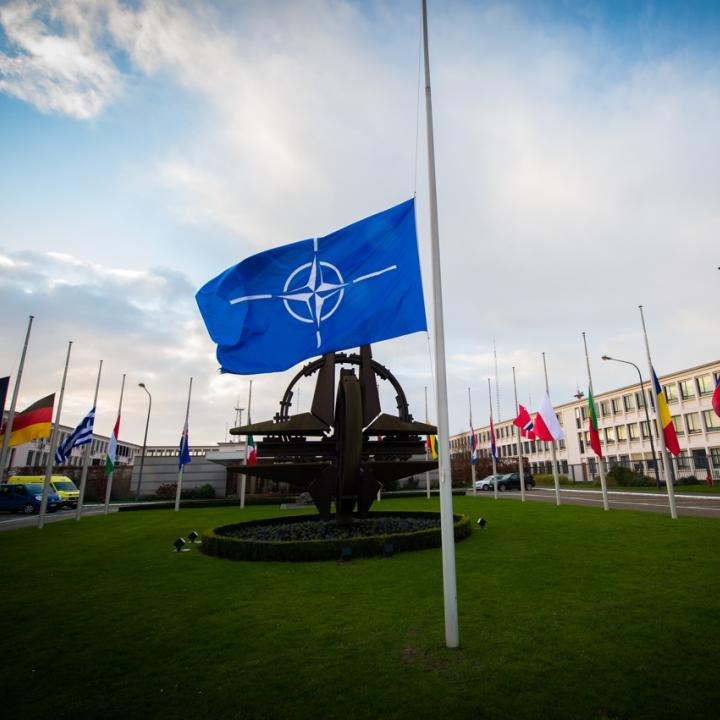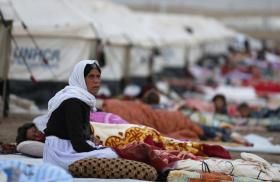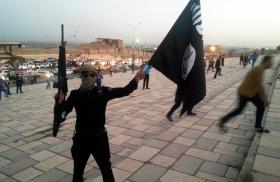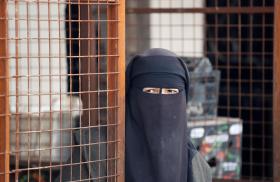
- Policy Analysis
- Counterterrorism Lecture
NATO Counterterrorism Trends: Current and Future Threats

Part of a series: Counterterrorism Lecture Series
or see Part 1: U.S. Efforts against Terrorism Financing: A View from the Private Sector
The alliance’s CT chief reflects on what member states, their militaries, and their international partners should focus on as they adapt to constantly evolving terrorist threats at home and abroad.
On March 17, The Washington Institute hosted a virtual Policy Forum with NATO counterterrorism head Gabriele Cascone. Mr. Cascone spent the first part of his career as an officer in the Carabinieri Corps and then joined the NATO International Staff, where he currently heads the Counterterrorism Section in the Emerging Security Challenges Division. The following is his statement for the record.
This forum offers an opportunity to outline NATO counterterrorism trends, including what the alliance is doing on this front, how these efforts have evolved, and what factors will shape them in the future. The key date and turning point for NATO CT is 9/11. Before that event, terrorism hardly figured in NATO’s work. For example, the NATO Strategic Concept approved at the 1999 summit in Washington only mentioned terrorism once: “Alliance security can be affected by other risks, including acts of terrorism.” The 9/11 attacks changed all of this, and it is important to remember that it was the only time in the alliance’s seventy-three years of existence that Article 5 of the Washington Treaty—the collective defence clause—was invoked.
What happened in the past couple decades allowed NATO to identify some key tenets of its counterterrorism role. The first point is that counterterrorism is and remains primarily a national responsibility. The idea is that it is first up to the allies to deal with terrorist threats. The second point is that terrorism is a cross-cutting issue that needs to be dealt with in the framework of all three NATO core tasks identified in the most recent Strategic Concept from 2010: collective defence, crisis management, and cooperative security. The third point is that NATO contributes to the international community’s fight against terrorism in situations where it has expertise, and where it can work in cooperation with international partners (nations or other international organisations). The final point is that the focus of NATO’s work has been based on three pillars: awareness, capabilities, and engagement. Let’s consider them in some detail:
Awareness. The first area that is relevant in increasing awareness is intelligence sharing among allies. NATO has a Joint Intelligence Security Division, within which has been established a Terrorism Intelligence Cell, which periodically releases products mostly focused on strategic intelligence (trends, modus operandi, developments in geographic areas). These are the foundations that can help us better identify and determine our response to terrorism.
Another element of awareness in which we are conducting some relevant work is the role of women in terrorism and counterterrorism, including a gender perspective. It is an area that has been little understood and little considered for many years. We can do more to better understand this dimension.
The third element of the awareness work is related to human security: children in armed conflict, protection of civilians, cultural property protection, and human trafficking. These are phenomena influenced or affected by terrorism. So what role could CT play in this regard?
Capabilities. Developing capabilities is the area more closely tied with the collective defence core task. It deals with what NATO is doing among allies to support the defence of our populations and our territories from terrorist attacks. The first item worth mentioning is the Defence Against Terrorism Programme of Work (DAT-POW) created in 2004. It is focused on dealing with allied capability shortfalls and urgent requirements, conducting technological research on CT efforts, and supporting the achievement and maintenance of technological dominance and interoperability. It focuses on how technology could support our work against terrorism and deals with issues such as counter-improvised explosive device (C-IED) efforts, protection of harbours, et cetera
The second element I would like to mention is the extensive work conducted on countering unmanned aircraft systems (UAS), particularly commercially modified drones. Our work is specifically related to countering low, slow, and small drones. These are becoming one of the weapons of choice for terrorist groups around the world. To this effect, we have established a NATO Working Group on countering UAS, which operates on the basis of a work programme focused on force protection, boosting security at home, and bringing coherence to NATO’s efforts. Although it may surprise some, at the beginning our work had to address such basic issues as having a lexicon to make sure we were using the same words to speak of the same things. Today, our efforts are directed toward standardization, interoperability, and tests/exercises.
Another area to which we have devoted considerable attention is technical exploitation (which may also be referred to as battlefield forensics). The idea is that military forces collect a lot of information and material on the battlefield. How can we bring this into a coherent process in order to support multiple outcomes, such as intelligence, force protection, and research and development? A lot of this work has already been conducted in operations in an ad hoc manner; the challenge here is to create a coherent process.
Related to this topic is the issue of battlefield evidence. One possible outcome of technical exploitation is to support law enforcement and legal proceedings, particularly with respect to the prosecution of foreign terrorist fighters (FTFs). In an operation, the military is the agency that gathers the information, which can then be used to help prosecute terrorists in their home countries or identify them when they try to cross borders. We have therefore developed a Battlefield Evidence policy and programme of work. Our main goal is to facilitate the sharing of information and material collected in NATO operations so they can be used in domestic jurisdictions, whether for prosecution, investigation, or simple identification.
Engagement. The engagement pillar is about cooperation with partner countries and international organisations. Through what we call counterterrorism dialogues, we try to understand what each partner needs from NATO and in which areas NATO would be able to provide assistance. Based on this identification of their needs and our capabilities, we help each country develop a programme of training, assistance, scientific projects, and so forth—all the tools that we have at our disposal in the NATO inventory to provide support. At the same time, the NATO community of partners is extensive and covers countries with various levels of expertise, so we also try to bring some of those countries into NATO’s work on capabilities where appropriate. In addition to assisting our partners, we are interested in how partners can help us do better and develop the right capabilities and measures.
In parallel, we also keep cooperation with other international organisations high on the agenda, engaging in mutually reinforcing processes with the United Nations, Interpol, European Union, and African Union. This also allows us to support and reach out to countries that are not NATO partners.
A final word on some initial work we are conducting to identify a possible NATO role in countering terrorist financing. So far, we have identified two initial ideas for this strand of work. The first challenge is how to prevent terrorists from financing themselves through the looting of cultural property. We should prepare to include this in our work, and in how we prepare our military forces for operational deployments. The second challenge is the exchange of financial information obtained in the course of technical exploitation/battlefield evidence activities. How could we share this information with the appropriate authorities? Preliminary contacts have been initiated with relevant international partners (Interpol, the Financial Action Task Force, the Egmont Group) to explore how to further pursue this initiative.
During the subsequent Q&A, Mr. Cascone supplemented his initial presentation with further remarks on various topics:
On Afghanistan, we need to remain careful in how we assess what is happening and what active players are still present there. In particular, we need to understand whether the current situation allows other terrorist groups to flourish, and to what extent these groups constitute a threat to NATO and individual allies.
In addition, our extensive operational deployment in Afghanistan helped the alliance realise that militaries can contribute a great deal more to global CT efforts in areas such as battlefield evidence, forensics, et cetera. We now need to take what we learned there and from our subsequent work on those topics and integrate it into the modus operandi of our military, ensuring that this knowledge and these capabilities are maintained and developed in case future deployments require them.
Regarding NATO’s “Hub for the South,” a number of key tasks have been initiated so far, such as mapping what is going on in North Africa, the Middle East, the Sahel, and sub-Saharan Africa, as well as what assistance projects are being carried out in these regions. This allows us to better identify the threat and the correct trend of efforts for NATO’s work and engagement with these countries. In addition to providing products of its own, this hub works in close cooperation with NATO headquarters in Brussels and with our military structures. Its main role is to keep a constant eye on realities and developments south of the alliance, which is a unique asset.
Regarding the evolution of the terrorist threat in Africa (particularly in the Sahel), NATO’s main area of effort at this stage is to improve the capabilities of our partners in the region. It is not so much an issue of direct involvement or deployment, but more about how we can strengthen the capabilities of the countries that are most directly affected by these terrorist groups. This includes supporting related efforts by the AU and UN.
As for counterterrorism efforts in Syria, NATO is a member of the Global Coalition Against Daesh. The main international actor in that space has been the global coalition, and NATO sees its role as a contributor to the coalition’s work, mostly through its NATO Mission Iraq, which focuses on training the Iraqi security forces at the tactical and institutional levels.
Regarding counter-UAS work, NATO’s main U.S. interlocutor (and Washington’s rep in the Working Group) is the Joint C-UAS Office in the Department of Defense. When it comes to cooperation with international organisations, much work is being done with the UN, Interpol, the EU institutions, and Eurocontrol. We also reach out to industries active in the field of C-UAS to learn from their research and knowledge.
As for helping partners in the Middle East-North Africa region with countering drone threats, NATO’s C-UAS work was started first and foremost to support the development of allies’ capabilities in this area. At the same time, we can obviously expect partners to knock on our door and ask for assistance. There is very interesting work that can be done, but it is important to do the right thing. We do not procure C-UAS equipment, but we can conduct research, identify the most effective countermeasures, and so on. We are starting to conduct experiments and exercises to test different countermeasures. Also, we should not ignore that there are partners who have C-UAS capabilities comparable to those of the allies. So we are also trying to involve a number of those partners in the activities of the C-UAS Working Group.
In addition, NATO has conducted extensive CT work with many of its MENA partners and will continue doing so. Examples include the work done with Jordan, where we conducted a mapping exercise to identify the CT support Jordan was already receiving from other countries and international organisations, thereby identifying gaps that NATO could fill. We are also putting forth significant effort in supporting Mauritania, which is not only a longstanding NATO partner but also one of the G5 Sahel countries (we are addressing CT and military aspects of border security). In addition, we have recently held discussions with Tunisia.
As for what this assistance means in practice, there is a set of different initiatives that very much depend on the demands of the partner in question. We conduct training (either in-country through Mobile Training Teams or at specialized NATO training institutions and Centres of Excellence), we support work in integrating the defence role in national CT architectures, and we try to foster interagency work.
Regarding gender and CT, the important point is developing a more exact understanding of what role gender plays in terrorism and counterterrorism. The traditional view is that women are victims of terrorism, but women actually play all the roles, including as supporters and active members.
The Policy Forum series is made possible through the generosity of the Florence and Robert Kaufman Family.






